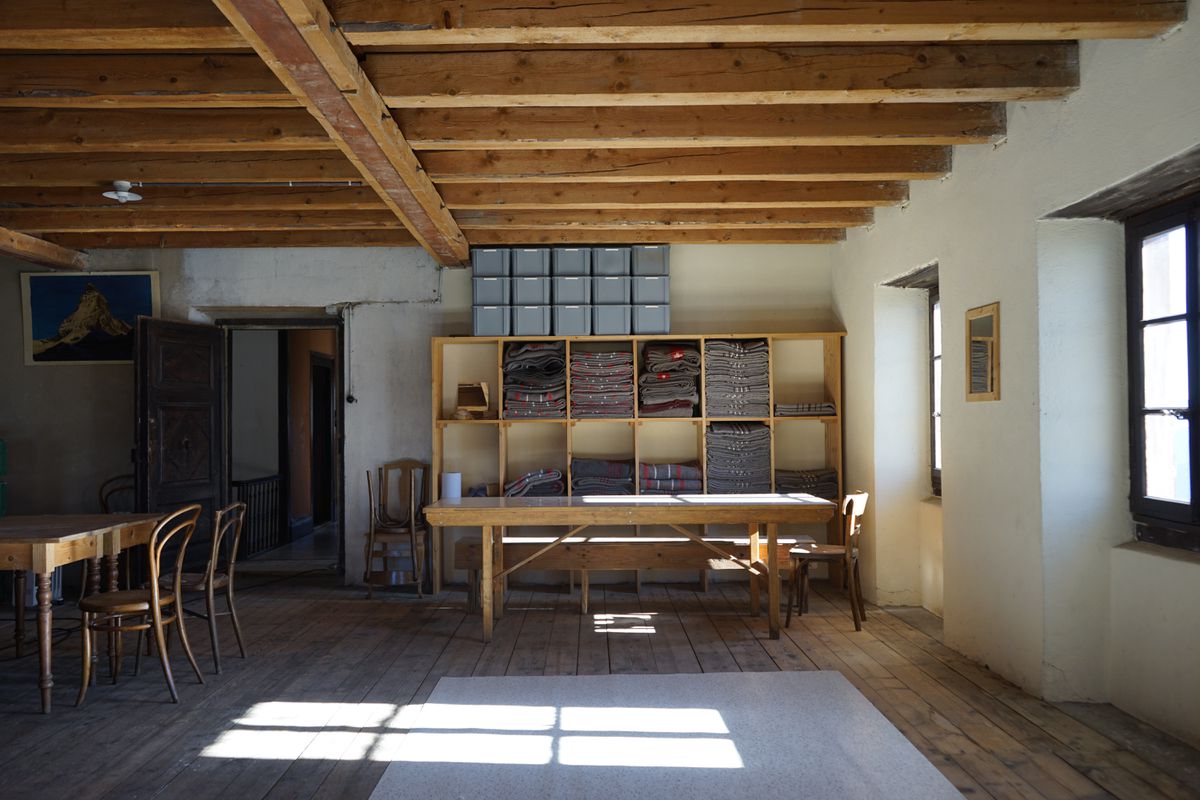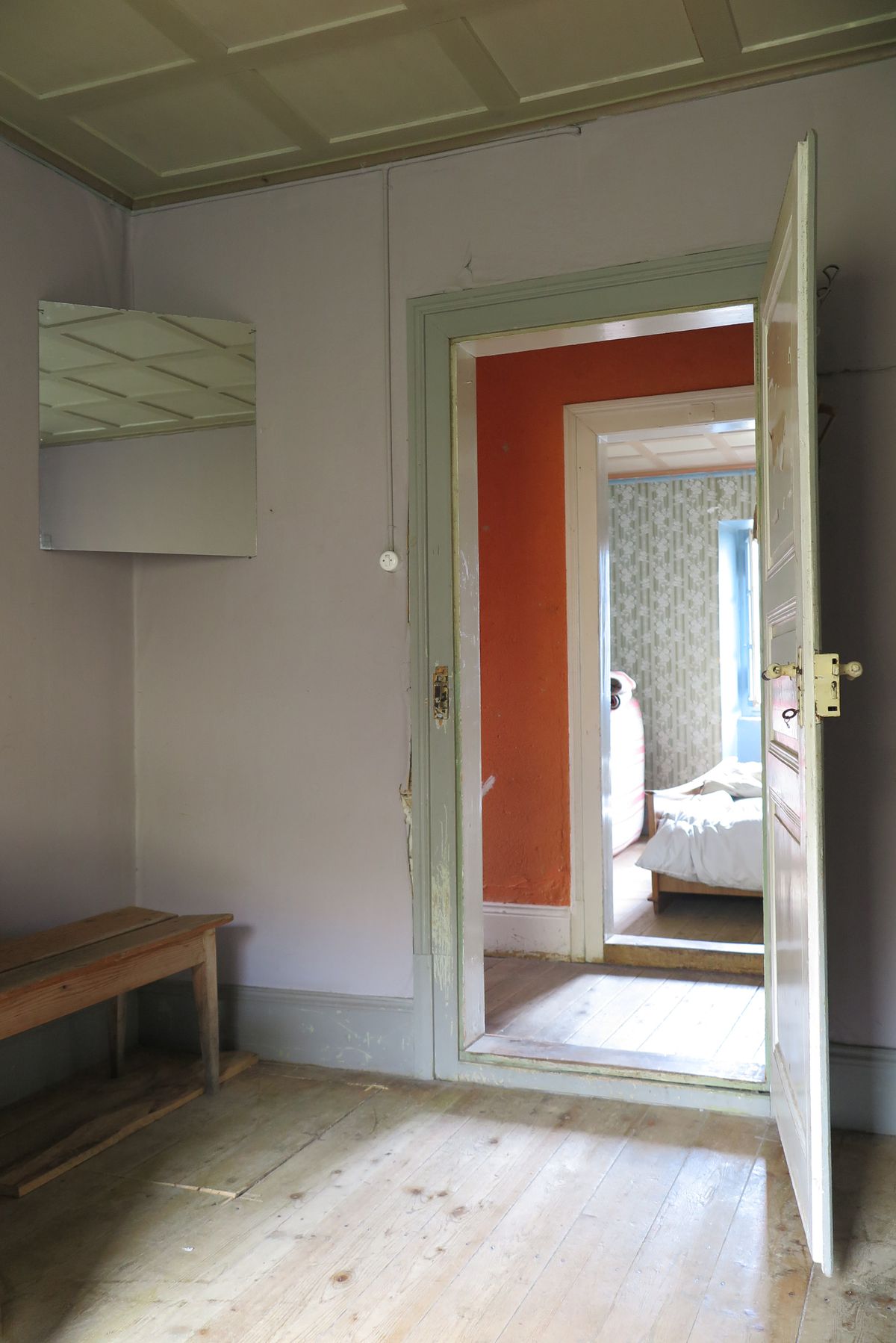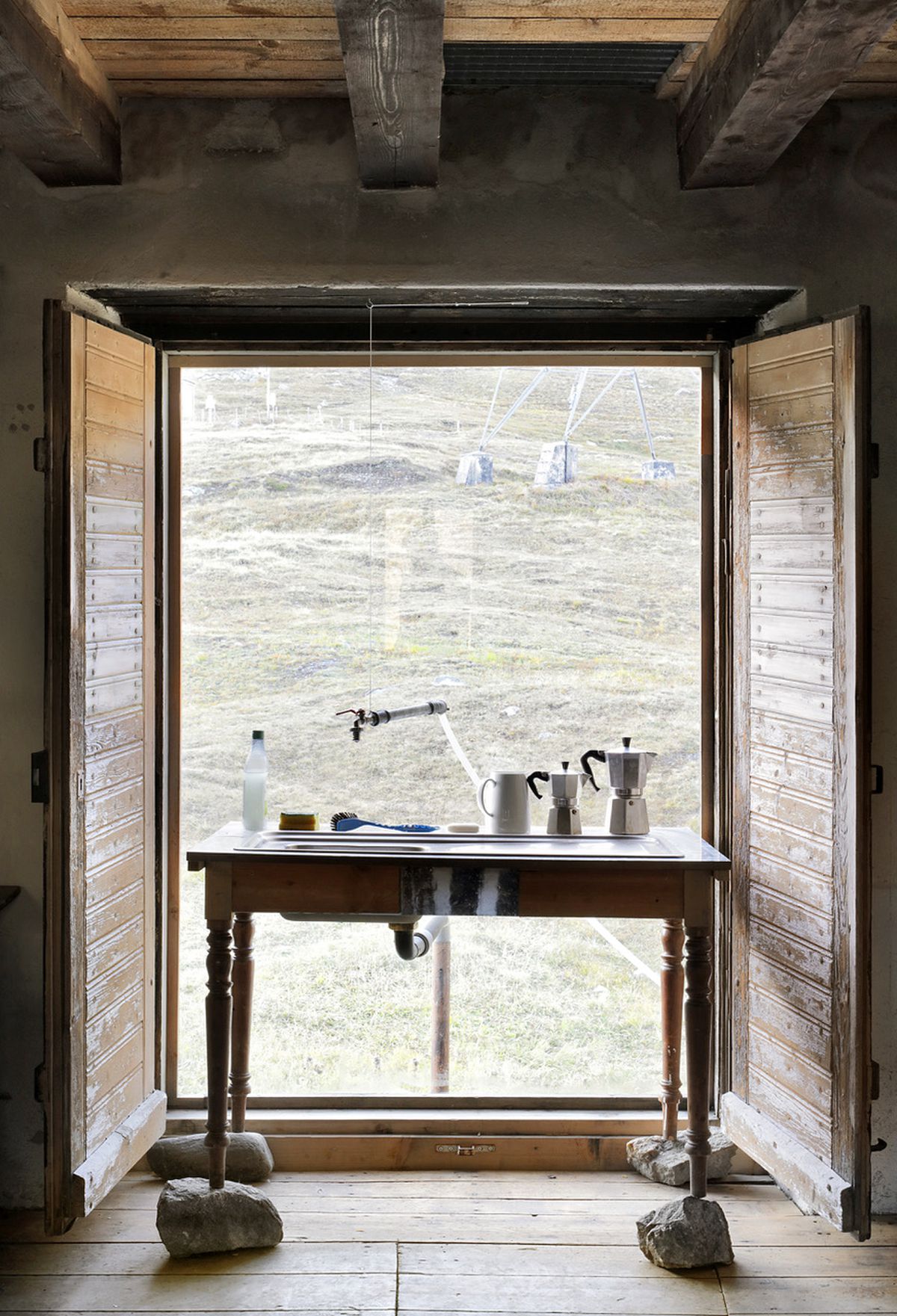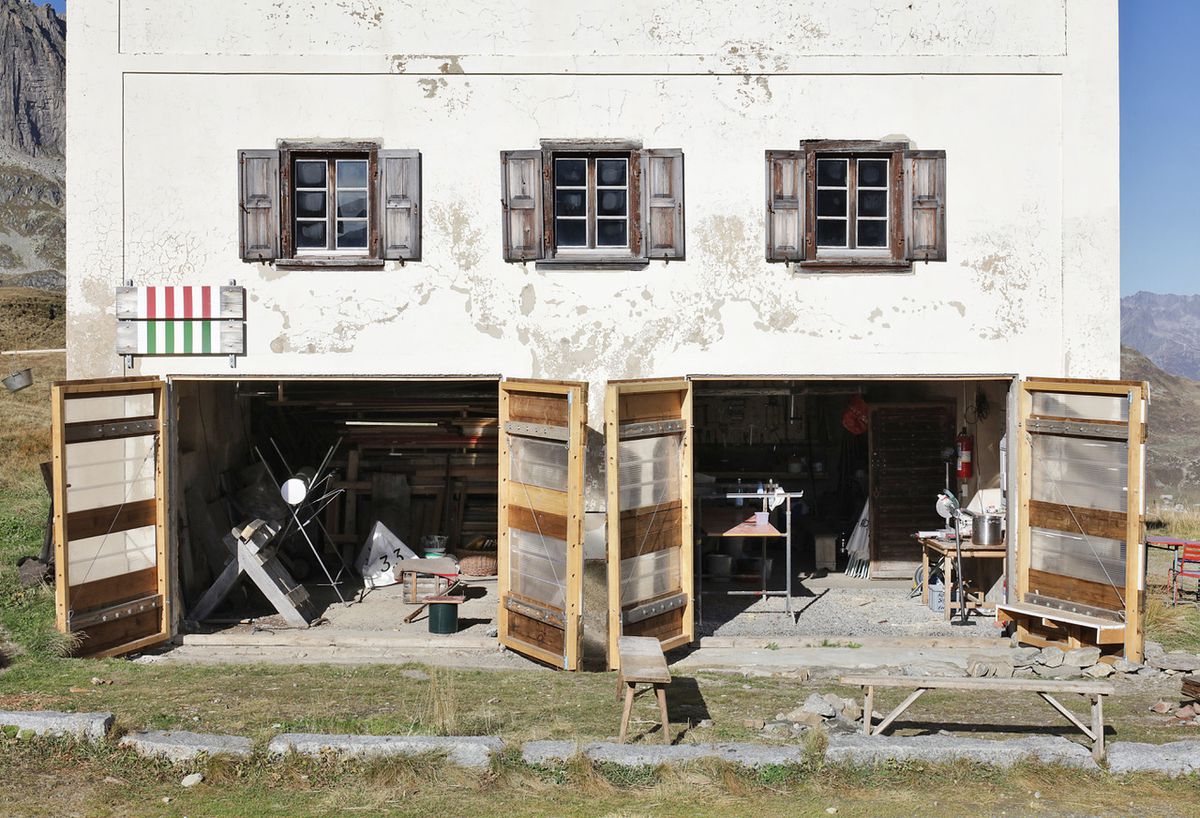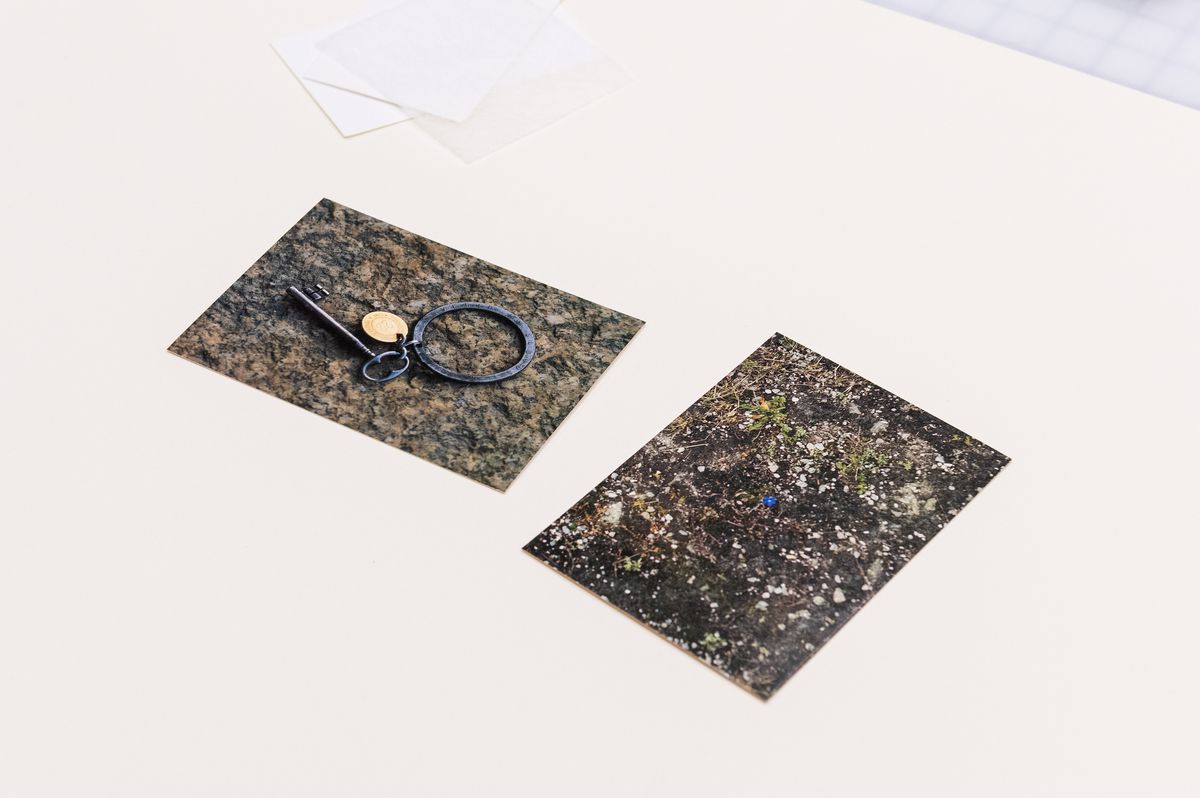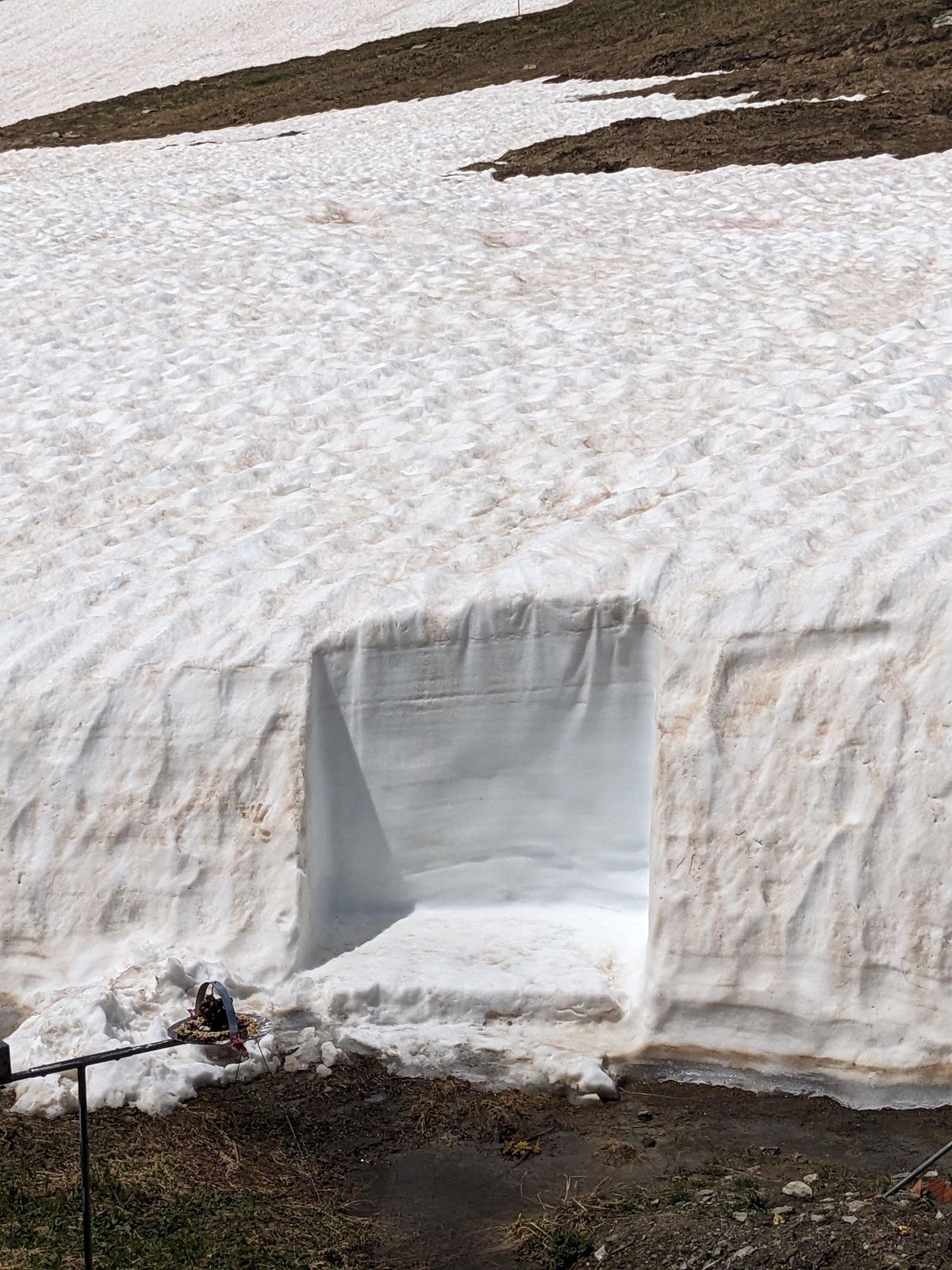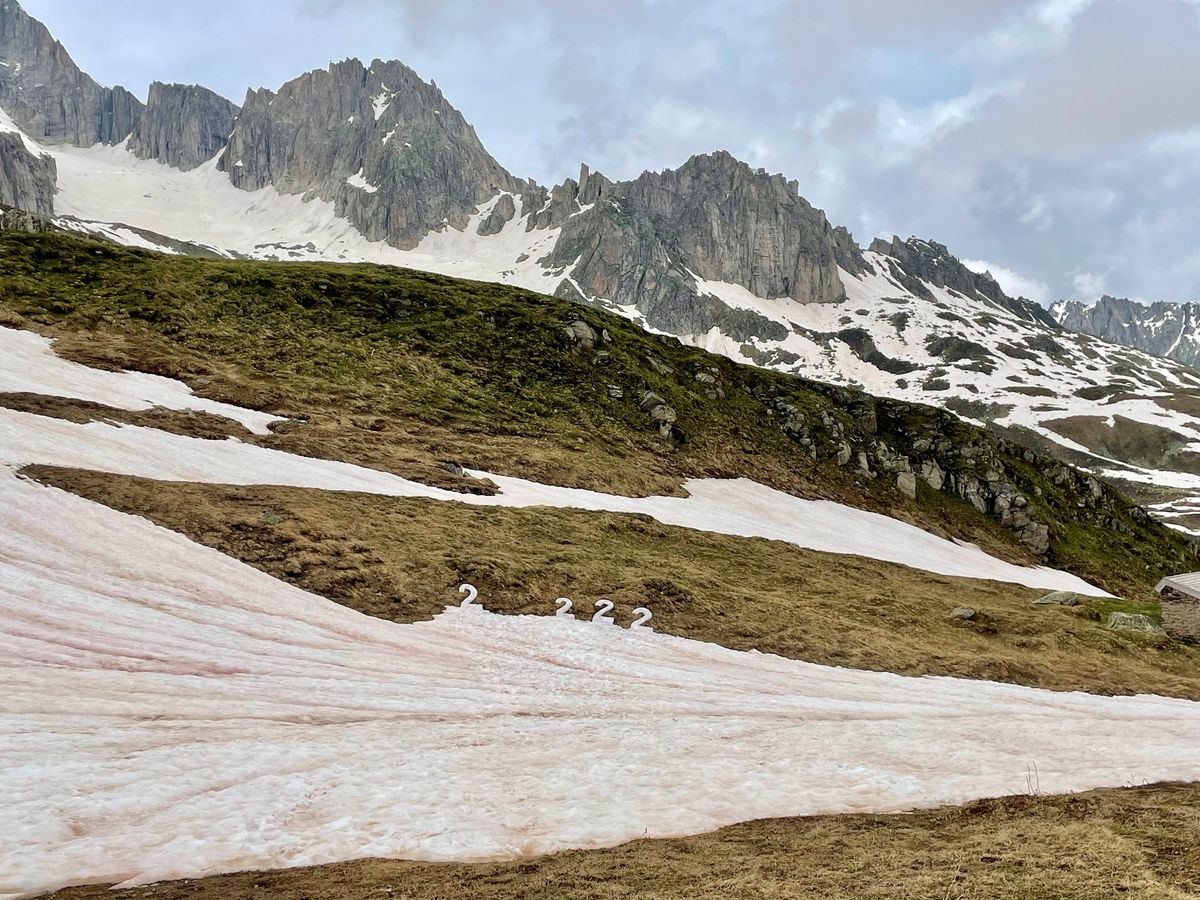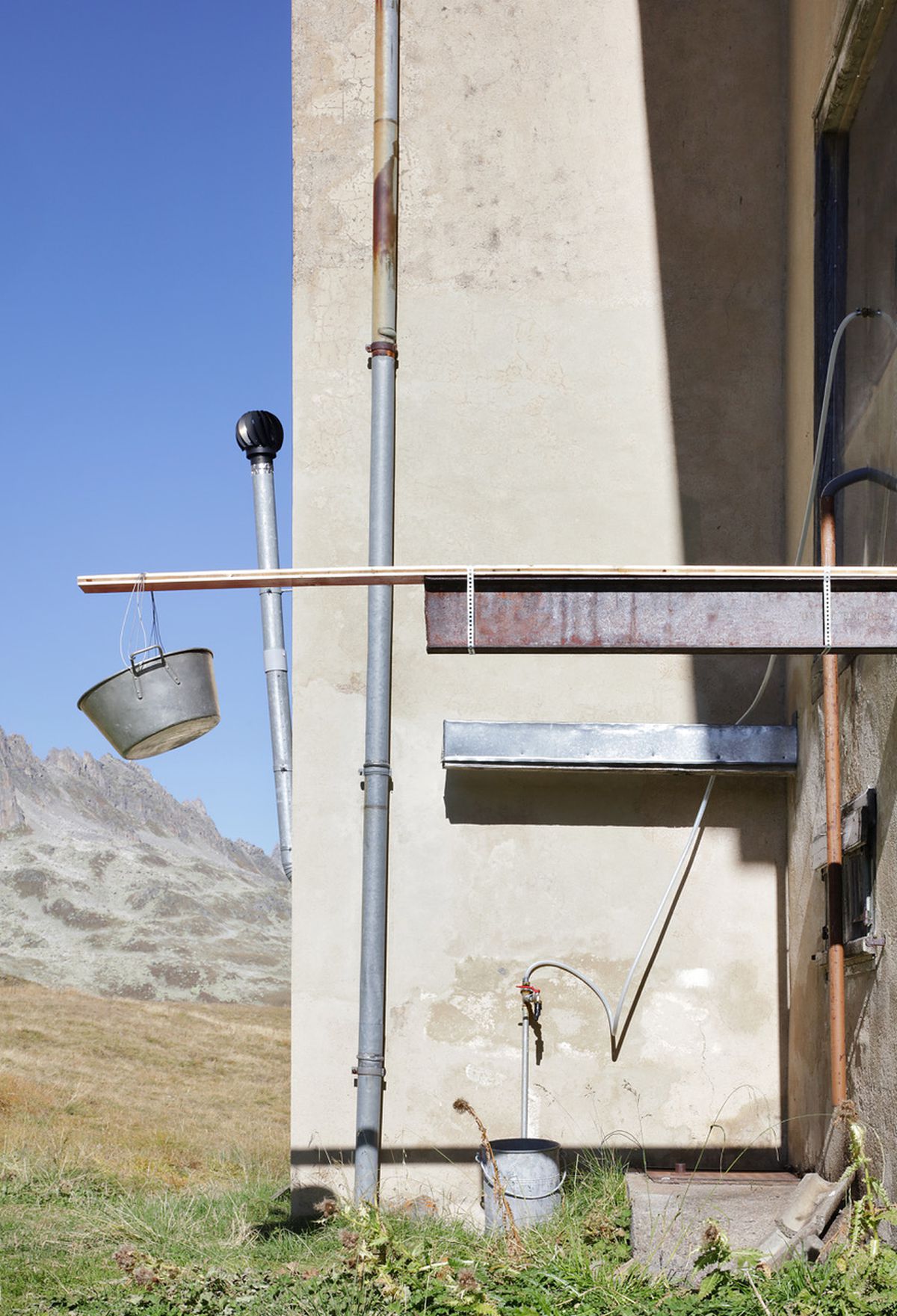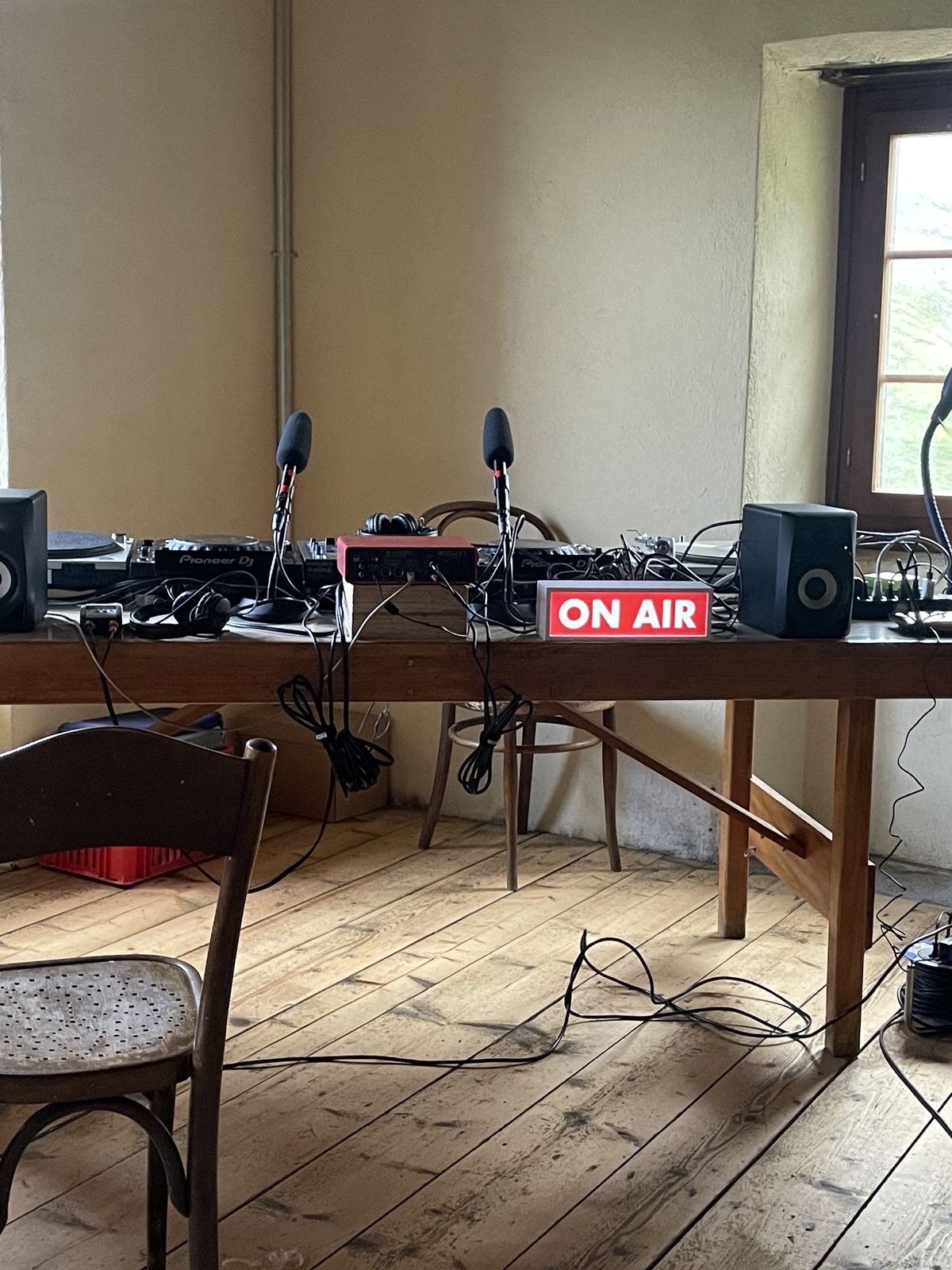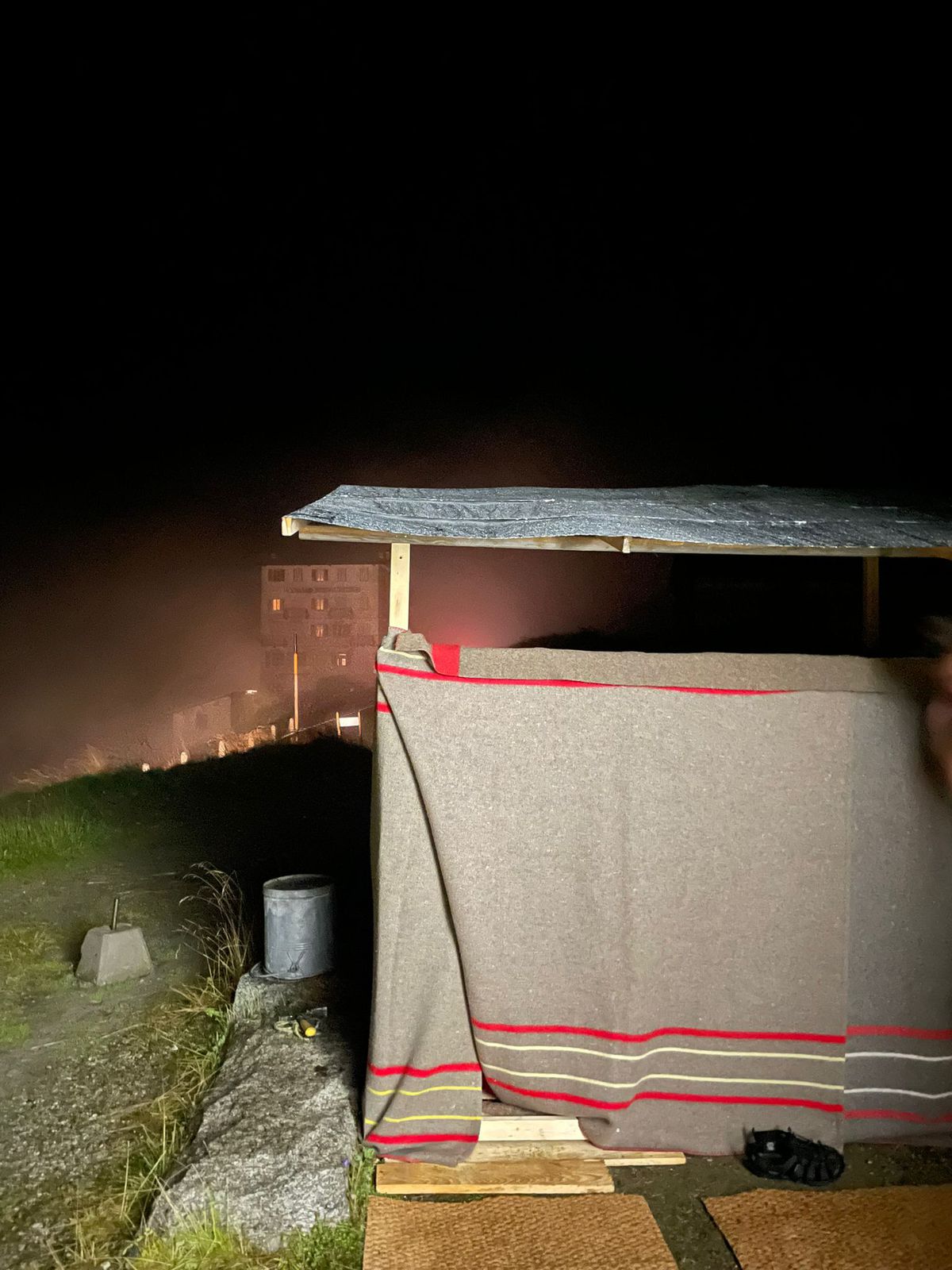Neighbours at Altitude
Ella Eßlinger on artist residencies at the Furka Pass
The infrastructure was very simple. A kitchen, a toilet, electricity, a shower for which water was heated in an immersion heater. Some of the beds, duvets, chairs, tables, plates, and cutlery had migrated from the Hotel Furkablick opposite the IN:DEPENDANCE. Through unfolding, (re)shuffling, installing one by one, twelve rooms became available. Comfort at the residence depended on the time of day and the weather—with frequent gusts of wind, it was cold inside the house itself. There were radiators on wheels, a pile of felt blankets, and hot water bottles available to keep warm. In the evenings, a sauna enclosed by Swiss army blankets was often heated. “We design the format of our presence. The content will follow. We have to look for it, together, through our presence, through our action.”1 This was the premise and the promise when the slowly decaying structure of the dépendance, an accessory building to the Hotel Furkablick overlooking the Furka Pass, was made available through the Alfred Richterich Foundation and reoccupied in 2022.
Over the course of three summers (2022–2024), the former dépendance was transformed into the IN:DEPENDANCE residency program and inhabited by a fluctuating number of guests, students, professors, artists, passers-by. Run by the share of architecture an(d) attitude of the Department of Architecture at ETH Zurich, IN:DEPENDANCE was put on by a small team consisting of Alessia Bertini, David Moser, and Jan De Vylder who ensured the framework for a “permanent presence”2 during the Furka Pass’s opening season. From mid-June to mid-September at 2429 metres above sea level, an overlapping cast of residents, from between one to up to twenty people, stayed there. This mode of continuity allowed one to observe, question, and understand a multilayered place. IN:DEPENDANCE was an attempt to bring a different kind of rhythm to the altitude. It offered a pattern of daily life that interrupted the mobility and sequential nature of passing tourists, cyclists, motorcyclists, and hikers chasing the panoramic view.
Only open for about three months each year, the Furka Pass is a high mountain pass in the Swiss Alps that connects the canton of Uri with the canton of Valais. In the nineteenth century, a modern road was built to replace the unpaved route dating back to Roman times. This development marked the beginning of alpine tourism in the region, and a series of hotels were constructed to accommodate the visitors. However, due to the region’s harsh weather and declining tourist interest over time, many of these hotels were unable to fulfill their original purpose and eventually had to close.
Before the dépendance became IN:DEPENDANCE, it was vacant for many years. Since the 1990s, it had only been used as a base camp for mountain guides exploring the surrounding landscape. But, between 1983–1999, another artist residency was shaping up at the nearby Hotel Furkablick, initiated by Swiss gallerist Marc Hostettler. When he started to invite local and international artists to participate in the Furkart residency and create works on site, the attention was logically focused on the main building, and its connection to its sibling building began to fade. Since 2004, the Hotel Furkablick (renamed the Furkablick Institute) and the artworks produced during the Furkart project have been preserved by the Alfred Richterich Foundation. Under the direction of Janis Osolin, the memory of those summer residencies endures, and the few permanent works scattered throughout the alpine landscape have been carefully conserved. The artistic significance of the Furkart project—combined with its seasonal exclusivity, which gradually attracted a growing circle of visitors—can now be traced through a series of postcards that document the activities of that time.
Looking at these postcards—an archival format that reveals the volatility of the site—stirs a longing to have been there. To see James Lee Byars spill a “Drop of Black Perfume” to inaugurate “the practically deserted and abandoned [far away place]”1 or to witness Dorothee von Windheim crush a small blue flower during her 1991 performance Ich zertrete eine blaue Blume… Unlocking one’s room with keys inscribed Covered by Clouds by Lawrence Weiner and “[spending] the night in one of the olde worlde bedrooms with those high beds of yesteryear that you literally had to climb into, and their mountainous eiderdowns”contributed to a lasting memory waking up at unusual altitude.2
While Furkart embraced ephemerality, IN:DEPENDANCE followed a different intention: it offered continuity. Its steady presence, in contrast to the sporadic visitors and short-term artist residents of Furkart, enabled it to function without hierarchy. Experts and amateurs lived and worked together as part of a transitory collective whose primary task was to be present and to record through what lens they experienced inhabiting the place. Over the course of the residency, fragments of memories and reflections steadily accumulated at IN:DEPENDANCE and were thus passed on to the next residents. Some interventions extended directly onto the building itself: a black painted rectangle mirroring the dimensions of the newly installed kitchen window beside it; shutters striped in reference to Daniel Buren’s work on the building opposite. Other gestures were more fleeting: a solar-powered grill, meditation, snow carvings, kite flying, and recording of the ambient soundscape. The short film Under the Ice was shot on site, and the radio station “Furkaradio” was founded there, now broadcasting from the centre of Zurich. Students cycled up the Furka Pass, canvases strapped to their backs, to paint at the top. The Baukunstklasse led by Inge Vinck at Kunstakademie Düsseldorf regularly stayed at the house and expanded perspectives on the site.1 A quilt workshop (“Quiltscapes”) led by artists added yet another layer to this constantly evolving site.2 This brief list can hardly capture the intricate web of care, observation, and experimentation that unfolded through the revitalization of the existing infrastructure, but perhaps it hints to the fact that there was, naturally, a certain intensity inherent to the experience of being there.
-
It is worth mentioning the great effort by Inge Vinck, her team, and the students from the Baukunstklasse at the Kunstakademie Düsseldorf, who organized several week-long events up at the pass. By inviting external contributors and schools up to IN:DEPENDANCE, the format was able to grow independently beyond its initial ties to ETH. ↩
-
Over the course of three years more than three hundred residents stayed at IN:DEPENDANCE. Mentioned here are the authors of the projects briefly cited in the text: Philippe Vander Maren, Martina Barcelloni Corte (painted rectangle); Lewis Horkulak, Ansgar Stadler, Nicolas König (solar-powered barbecue); Lya Mahée Steiger, Bodo Brägger (snow work); CickinDunt (another snow work; Julia Liedl (snow queen); Jim König, Vittoria Guglielmi (kite); Michel Kessler, David Oesch (short film: Under the Ice); Annexe (sound recordings); Carolina Catarino Gomes, Lea Graziani (Furkaradio); Jan Przedpelski (bike with canvas); Brigham Baker, Karolin Braegger (Quiltscapes, quilt workshop, participants: Brigham Baker, Karolin Braegger, Clementine Barnes, Axelle Stiefel Martian M. Mächler, Martina Buzzi, Miruh Frutiger, Raffaela Boss, Domi Wyss, Alena Spörri Chiara, Lya Mahée Steiger, Bodo Braegger, Kathrin Füglister, Moritz Lehner, Anna Mineeva, Vitaly Cherepanov, Jakob Walter, Juliette Uzor, Sven Gex, Grace Prince), as well as other residents who spontaneously joined the program: Jaime Irving, Joana de la Fontaine, Marta Cassany, Maša Mori. ↩
In recent years, Janis Osolin, together with artist Liliana Sánchez and the organizers of Furkablick restaurant, have lived in the former Hotel Furkablick, while numerous participants of the residency program have inhabited the IN:DEPENDANCE. Through the collective efforts of the respective occupants, both buildings have found independent uses, yet have also been drawn closer in spirit. Furkart, its continuation Institut Furkablick, and IN:DEPENDANCE have all contributed to building and sustaining a unique energy at altitude. Since last summer, both buildings have been listed for sale. A large sign À Vendre [For sale] by artist Guillaume Bijl now marks the site, referencing the artist’s 1986 work Zu vermieten [For rent] on another building on the Pass.1 A farewell celebration at IN:DEPENDANCE was held in September 2024. The continuous presence of its residents has extended the life of these buildings and created a mode of living and working together that will not be easily replicated.
-
“Historic home of Furk’Art goes up for sale,” Artforum, 30 July 2024, https://www.artforum.com/news/historic-home-furkart-goes-up-for-sale-557112/. ↩
